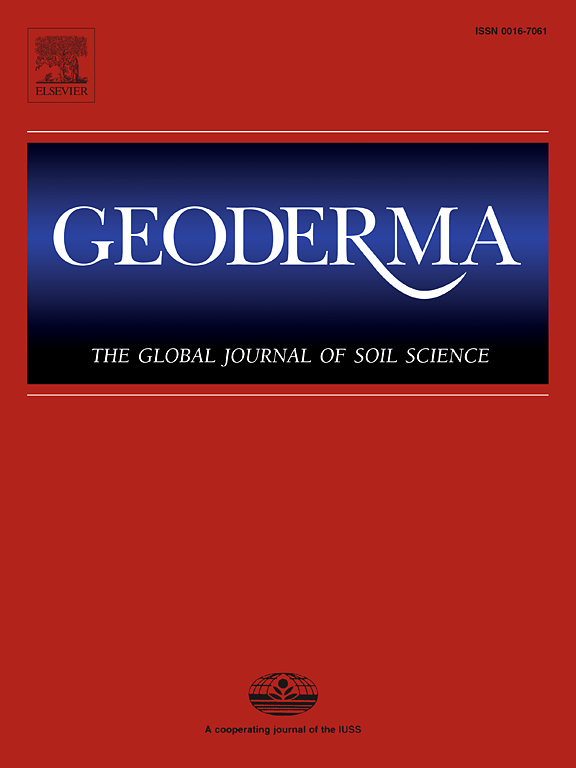Impact of a synthetic zeolite mixed with soils of different pedological characteristics on soil physical quality indices
IF 5.6
1区 农林科学
Q1 SOIL SCIENCE
引用次数: 0
Abstract
The addition of natural or synthetic zeolites induces changes in a soil’s chemical, physical, and biological characteristics. Zeolites possess intricate internal frameworks that allow them to modify soil structure and texture, thereby impacting soil hydrological properties. This potential offers opportunities to control soil and groundwater pollution as well as optimize irrigation management practices. In this study, three sandy-loam soils and a silty-loam soil were collected and mixed with different amounts of synthetic zeolite derived from coal fly ash. Repacked soil samples were combined with four levels of zeolite ranging from 1% to 10% by weight and were then hydraulically characterized. This included measuring soil water retention curves (SWRCs) of soil-zeolite mixtures. The data revealed, in accordance with recent research findings, that zeolite influences the hydraulic behavior of soils. In general, we observed that, as the percentage of zeolite increases in the soil, the SWRCs are shifted upwards. This effect is fundamental for explaining the observed changes in the whole set of investigated soil hydraulic properties. The observed changes are also fundamental to evaluate selected soil physical quality (SPQ) indices of agronomic interest, which are investigated in depth in the present research. A specific focus was on the impact of zeolite on modifying the soil’s capacity to retain water, hence on the energy required by plants to acquire a unit mass of soil water (referred to as integral energy, EI). Finally, the ANOVA test, linear regression, and multivariate analysis were performed on the entire dataset to support, from a statistical standpoint, the observed correlations between SPQ indices and zeolite amounts. These findings underscored the significance of soil texture in selecting the appropriate soil type for zeolite amendment, confirming that coarse-textured soils are more suitable for zeolite treatment compared to fine-textured soils.
合成沸石与不同土壤学特征的土壤混合后对土壤物理质量指标的影响
添加天然或合成沸石会导致土壤的化学、物理和生物特性发生变化。沸石具有复杂的内部框架,可以改变土壤结构和质地,从而影响土壤的水文特性。这种潜力为控制土壤和地下水污染以及优化灌溉管理方法提供了机会。在这项研究中,收集了三种砂质壤土和一种淤泥质壤土,并将其与不同量的从粉煤灰中提取的合成沸石混合。重新包装的土壤样本与按重量计从 1% 到 10% 不等的四种沸石混合,然后进行水力表征。这包括测量土壤-沸石混合物的土壤保水曲线(SWRC)。数据显示,与最近的研究结果一致,沸石会影响土壤的水力行为。一般来说,我们观察到,随着土壤中沸石比例的增加,SWRC 向上移动。这种效应是解释所观察到的整套土壤水力特性变化的根本原因。观察到的变化也是评估选定的农艺土壤物理质量(SPQ)指数的基础,本研究对这些指数进行了深入调查。具体重点是沸石对改变土壤保水能力的影响,从而影响植物获取单位质量土壤水所需的能量(称为积分能,EI)。最后,对整个数据集进行了方差分析、线性回归和多元分析,从统计学角度证实了观察到的 SPQ 指数与沸石数量之间的相关性。这些发现强调了土壤质地对选择合适的土壤类型进行沸石改良的重要性,证实与质地细的土壤相比,质地粗的土壤更适合沸石处理。
本文章由计算机程序翻译,如有差异,请以英文原文为准。
求助全文
约1分钟内获得全文
求助全文
来源期刊

Geoderma
农林科学-土壤科学
CiteScore
11.80
自引率
6.60%
发文量
597
审稿时长
58 days
期刊介绍:
Geoderma - the global journal of soil science - welcomes authors, readers and soil research from all parts of the world, encourages worldwide soil studies, and embraces all aspects of soil science and its associated pedagogy. The journal particularly welcomes interdisciplinary work focusing on dynamic soil processes and functions across space and time.
 求助内容:
求助内容: 应助结果提醒方式:
应助结果提醒方式:


